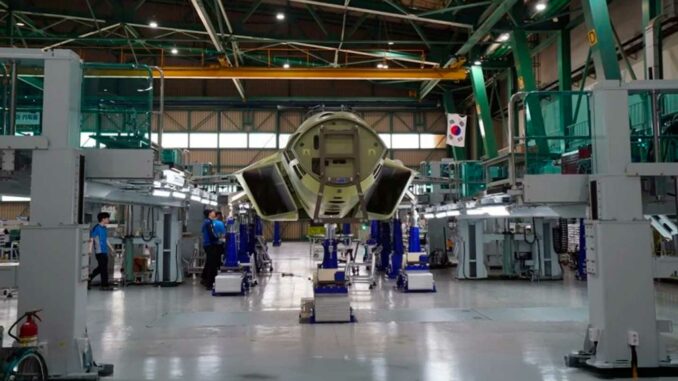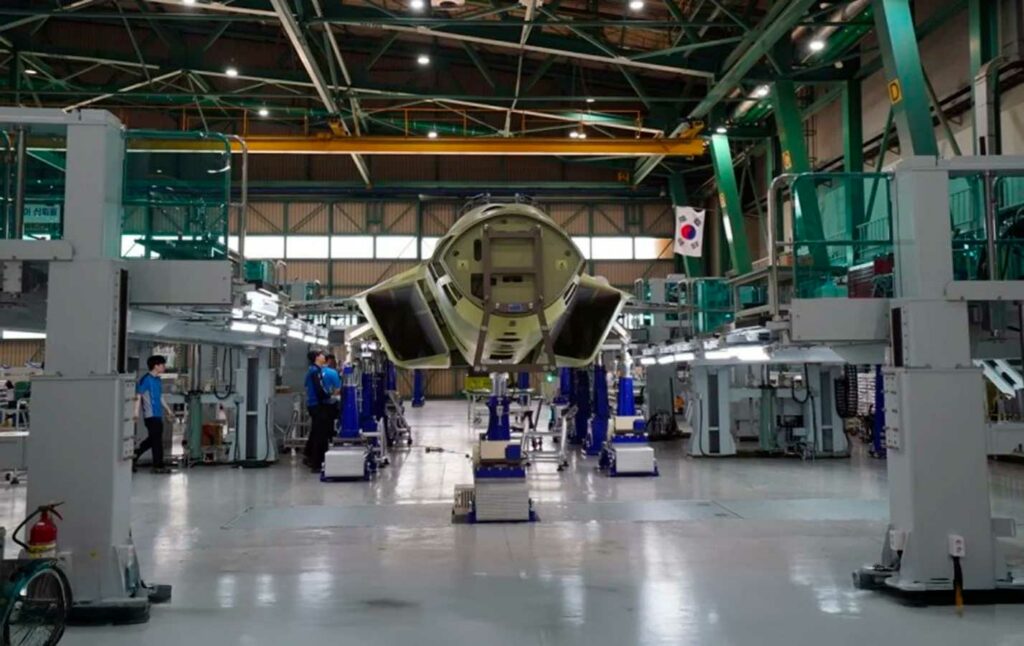
South Korea is finalizing the assembly of its first KF-21 fighter jet, designed to modernize its air fleet by 2032.
The KF-21 Boramae, developed by Korea Aerospace Industries (KAI), is entering series production. South Korea has begun assembly of the first production model, with 12 aircraft currently under construction and a new contract for 20 additional units planned for June 2025. This 4.5-generation multirole fighter, equipped with stealth capabilities and advanced sensors, is intended to replace the older F-4 and F-5 aircraft, while complementing the F-35 fleet. The South Korean Air Force (ROKAF) plans to begin operational service in 2026, with a total fleet of 120 aircraft by 2032.
Industrial ramp-up for the KF-21 Boramae fighter
The KF-21 Boramae (meaning “falcon” in Korean) is one of South Korea’s most ambitious aerospace programs. According to official sources reported by South Korean media, assembly of the first production model is progressing smoothly. Currently, twelve aircraft are in production at the Korea Aerospace Industries (KAI) facility in Sacheon.
Work is progressing on schedule, with a second production contract for 21 additional units expected in June 2025. This pace suggests a controlled industrial capacity, supported by a state strategy of technological independence.
The production program includes:
- operational entry into service in 2026 after flight tests and ground evaluations,
- delivery of the first 40 aircraft by 2028,
- and a total target of 120 fighters delivered by 2032.
This pace reflects a clear desire to rapidly renew the Republic of Korea’s combat capabilities, particularly in light of the modernization of China’s air force and military pressure from North Korea.
A 4.5 generation architecture adapted to contemporary challenges
The KF-21 is classified as a 4.5 generation aircraft, intermediate between fourth-generation aircraft (such as the F-16 or Rafale) and fifth-generation aircraft such as the F-35A Lightning II.
The Boramae incorporates modern features and enhanced compatibility:
- stealth design elements, reducing radar signature,
- AESA (Active Electronically Scanned Array) radar of Korean design,
- digital cockpit with touchscreen interface,
- compatibility with Western and domestic weapon systems, including the Meteor air-to-air missile and GPS-guided bombs.
The aircraft has an estimated maximum speed of Mach 1.8, with a range of over 2,900 kilometers in standard configuration. Its operational ceiling exceeds 15,000 meters, enabling it to perform air superiority, interception, and ground support missions.
The aim is to provide a technologically advanced but more affordable alternative to fifth-generation fighters, particularly for future exports, targeting countries such as Indonesia, a partner in the initial project.

A response to South Korea’s aging fleet
The KF-21 program was launched to gradually replace the McDonnell Douglas F-4 Phantom II and Northrop F-5 Tiger II still in service with the ROKAF. These aircraft, introduced in the 1970s, now have significant structural and operational limitations.
Replacing these aircraft is urgent for safety reasons:
- they are expensive to maintain and increasingly complex,
- they are unsuitable for modern threats, particularly in the face of the growing electronic capabilities of enemy forces,
- their operational availability rate is falling to less than 60% according to South Korean military data.
The KF-21 will not only reduce dependence on foreign suppliers, but also strengthen domestic production capabilities in military aeronautics. KAI has also indicated that 65% of the aircraft’s components are produced locally, a ratio that is expected to increase in future iterations.
Close coordination with South Korean F-35s
The KF-21 program is not intended to compete with the F-35A already in service with the ROKAF. On the contrary, the two platforms are designed to complement each other: the F-35 will carry out high-penetration missions with increased stealth, while the KF-21 will be positioned as a more flexible and less expensive multirole aircraft.
For comparison:
| Characteristics | KF-21 Boramae | F-35A Lightning II |
|---|---|---|
| Max speed | Mach 1.8 | Mach 1.6 |
| Radar signature | Reduced | Very low (stealth) |
| Range | 2,900 km | 2,200 km |
| Estimated unit cost | €65 to €70 million | €85 to €100 million |
The ROKAF plans to field 40 F-35As and 120 KF-21s by 2032, forming a substantial air interception and projection core that is better suited to regional needs.
An industrial ambition focused on exports
In parallel with its domestic needs, South Korea aims to export the KF-21 to emerging markets and strategic partners. Indonesia, initially a partner in the program with 20% of the funding, could be the first export customer, although payment disputes have delayed its participation.
KAI is also targeting other markets, including:
- the Gulf countries (UAE, Saudi Arabia),
- Southeast Asian nations (Philippines, Malaysia),
- African and South American countries looking for an affordable, high-performance fighter.
The South Korean industry is banking on:
- a unit cost of less than €70 million,
- simplified maintenance compared to NATO standards,
- customizable weaponry options.
This would enable the KF-21 to position itself in a segment currently dominated by aircraft such as Saab’s Gripen E and Dassault Aviation’s Rafale F3R.
War Wings Daily is an independant magazine.